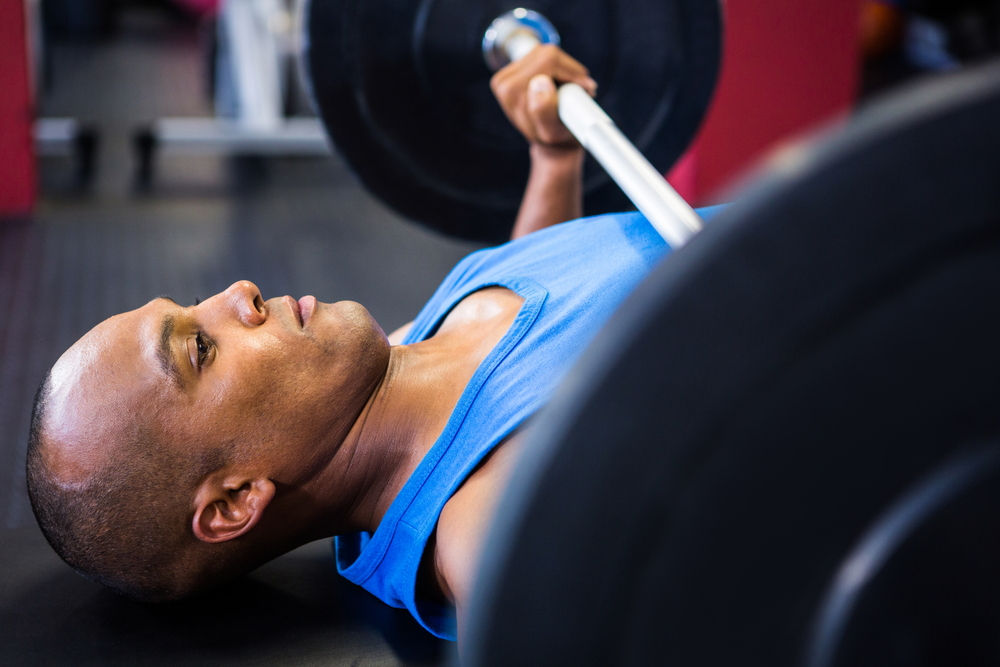How to do barbell thrusters
This is a short overview of the most effective barbell exercises which beginners can do. I left the Olympic lifts out on purpose as they are harder to learn than this selection.
Tension
Tension is one of the most underrated and overlooked topics for beginners. The effect of any exercise you can do in the gym is amplified by building maximum tension in your body.
From head to toe, your body should be ready and in position. This demands mental focus. Engage your core. Stack your bones. You want to be a metal rod and not spaghetti. Especially when it comes to lifting heavyweights.
The two major parts of building tension are your breathing and your grip on the weight. Fill your body with a little bit of air and press all your muscles out. Grip the bar as hard as you can. Only these two actions will already bring your maximum strength significantly up. Focus on intent and see the results.
How to barbell row
The barbell row is underutilized. It is tempting to spend a lot of time pushing and too little on pulling exercises. In the long-run, this will create imbalances that lead to suboptimal performance.
-
From the ground
-
From blocks
-
With body English
-
Without body English
The most taught version is the barbell row from the ground without body English. Body English means that you use your entire body for the row. Many coaches deem this dangerous. However, world record deadlift athletes like Cailer Woolam and Ed Coan recommend the row with a lot of body English. Less common variations of the row start on a block.
The argument for body English is to pull more weight. Train your rows heavy by incorporating your entire body into the movement. The trade-off is a higher injury risk. Without body English, you will have more activation of the back for muscle growth but less work of the body as a unit.
How to barbell squat
The barbell squat is one of the three big lifts in powerlifting. It is also one of the core lifts for weightlifters in their training. Especially when they are beginners. There are many variations of the barbell squat. The main ones are:
-
Low bar
-
High bar
-
Wide stance
-
Narrow stance
The first thing to distinguish is the position of the bar on your back. This is highly depending on how close your arms are to your shoulders when you set up for the squat. The bigger the lifter and the less mobility you have the wider the grip is. The smaller the lifter and more flexible the closer the grip is.
The high bar squat is usually preferred by weightlifters. They want to optimize to get under the weight as fast as possible to then get it back up again. The low bar squat is usually preferred by powerlifters. While it provides less speed it gives you a bigger shelf and more activation of the lower back. This adds pounds to your back squat which is tested in powerlifting while it is not relevant in weightlifting competitions.
The stance for the squat depends on your hip flexibility and structure. The bones of the upper legs can attach in different ways to the hips. This is based on genetics. The structure of your hip will determine whether the mechanics of a wide or narrow stance make more sense for you.
The wider stance is usually preferred by sumo deadlifters. It provides a more stable base and a shorter distance to travel for the bar. In return, the leverage out of the hole for movement no the bar up fast is not great.
A narrow stance is usually preferred by weightlifters. This provides a less stable base for the squat. It also demands more mobility in the hip and knees to complete the back squat. The trade-off is that you can use more speed and bounce to get the weight back up.
Experiment with different bar positions and stances. The one where you naturally feel the strongest is most often the best to start with.
How to barbell shoulder press
There are different versions of bringing a barbell over your head. These different variations fuel hot debates on the Internet of whether someone is cheating or not. Some of the most popular variations are:
-
Military press
-
Push Press
-
Jerk
The military press can be found in programs like Stronglifts, Wendler 531 and Powerlifting AI. This form of bringing a bar overhead demands no leg drive or dipping at all. Bring the bar to the chest and press it up only with your arms. This is the hardest press you can do with a barbell.
The push press is a variation on the military press. Here you are allowed to drive from the legs and hips. This will enable you to make the first quarter to half of the press a lot easier. The debate between push press and the military press is one that occasionally gets the online blood boiling.
The jerk is the most technical of the overhead presses and allows you to get the most weight over your head. The big difference between the military and push press is that you will dip with your body as low as you can under the bar. Some use the split jerk, while others keep their feet in parallel. Just watch Pyrros Dimas get an idea.
How to do barbell thrusters
Barbell thrusters have gained popularity with the CrossFit workout, Fran. A thruster starts with the barbell in the front rack position. From there you perform a front squat combined with a push press. This is also called a thruster.
The key to a good thruster is the fluidity of motion. This makes it the most energy-efficient. Many people stop on the way up to then perform a press. This will eat up more energy than using the leg drive to your advantage in the push press.
How to barbell bench press
There are different variations of the bench press. The most common ones are:
- Wide grip
- Narrow grip
- Leg drive
- No leg drive
One decision to make for the barbell bench press is how wide your grip will be. The wider the grip, the shorter the way the bar has to travel. In terms of muscle activation a wider grip will activate the chest more and tricep less. The narrower the grip becomes the more the focus of the exercise switches from the chest to the triceps. The bar will also have further to travel.
Another decision is to know whether you want to use leg drive or not. To maximize leg drive in the bench press you will form an arch. This is usually how powerlifters perform the bench press. Some Bodybuilders want to take the leg drive out of the equation. The goal is here to fully focus on the chest muscles to develop them. Which variation you prefer depends on your goals and training style.
How to barbell deadlift
The deadlift is the lift that moves the biggest weights. You start at the floor and end at the hip. There are multiple ways to get there and I will go over some of them here.
- Conventional
- Sumo
- Oberhand grip
- Mixed grip
- Hook grip
The conventional deadlift is the variation which most people do when they first walk up to the bar. The legs are about shoulder-width apart. You grip the bar just outside the legs. From there you bring it up to the hips. Bigger and heavier lifters usually prefer this variation of the deadlift, as they lack the mobility to do the sumo deadlift.
The sumo deadlift starts with the legs wide apart. You grip the bar inside of your legs. From here you pull the bar up until your hips are straight. The sumo deadlift is usually preferred by more compact, smaller lifters who have the hip mobility to perform the lift.
The conventional deadlift usually gives you more leverage off the ground but the bar has to travel further to complete the lift. If the weight leaves the ground, lifters usually have a higher chance to fail on the way up than with a dime deadlift. The sumo deadlift gives you poorer leverage off the ground, but a shorter distance to travel for the bar. Once you get the weight off the ground, you will complete the lift in most cases.
Summary
Play around with different variations of these lifts to find the one which is best for you. If you have a powerlifting coach, listen to their advice, even if the cha he feels uncomfortable at first. They usually know based on your physique which leverages will give you the most advantage.


